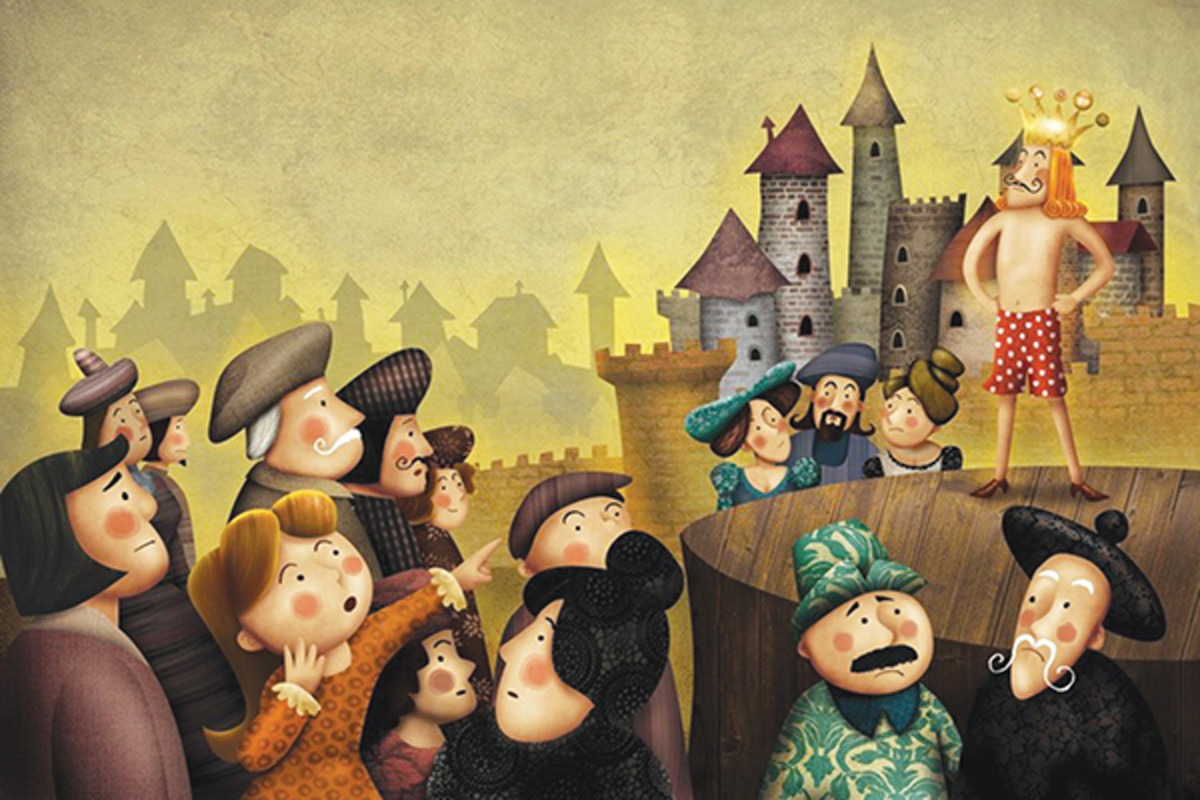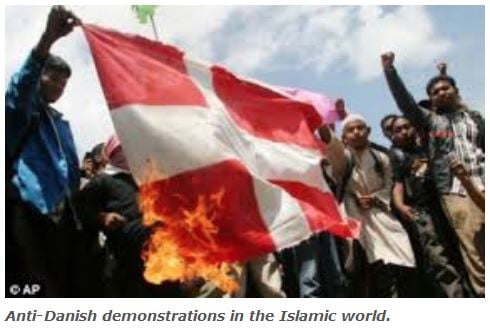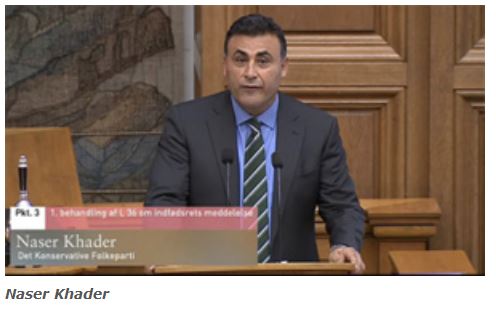The Danish Experience with Jews and Muslims
by Norman Berdichevsky (December 2017)

The Emperor’s New Clothes, Roberto Weigand
Denmark of the mid-nineteenth century set a marvelous example of community relations and brotherhood based on mutual respect. It was possible because a small minority had seen how it was incumbent upon them to win the respect of their neighbors. In today’s topsy-turvy world, Denmark and other nations are struggling to maintain their noble traditions and culture in the face of provocation from a militant minority of Muslim immigrants that is seeking to impose its will and culture/religion on the majority.
Until the mid-1980s, Denmark was still, along with Iceland and Portugal, the most homogeneous (some observers would therefore conclude the most boring) country in Europe. The population was almost entirely of ethnic Danish origin, speaking Danish and overwhelmingly members of the state Lutheran church (or non-observant) with no significant cultural, linguistic, ethnic or religious minorities. The only historical dispute involving a neighboring country with claims to kinship with a minority in the country involved the German community in South Jutland (also known as South Schleswig). Relations between Germany and Denmark over their respective minority populations were settled in a number of agreements following World War II and ended the only minor irritant among NATO members. Both minorities received assurances of full civil rights and establishing cultural institutions to maintain their respective identities (see Danish Dilemmas: South Schleswig after World War II; The Danish-German Border Crisis of 1945-1950) World Affairs Journal. No immigrant group was ‘visible’ except a tiny Jewish community in Copenhagen and ethnic Greenlanders who were all Danish citizens and Danish speaking.
This began to radically change in the 1980s when large numbers of immigrants received the right to settle and work in the country to fill a shortage of labor. The one groups that established a highly visible presence consisted of Muslims from the Middle East. How have they fared and how do they compare with the veteran Jewish community? This is of interest to many Americans as Denmark has often been given prominence by those on the political Left as a model to follow.
Eliza Grey, writing in TIME magazine in October, 2015 and commenting on the democratic Primary debate between Senators Hillary Clinton and Bernie Sanders, had this to say, “There is no question about who came out strongest in the debate, Denmark!”
Both candidates, exclaimed how much they and all Democrats love Denmark, the ideal model of so many Americans, many of whom would be hard pressed to reveal any knowledge at all about the country, its history and geography, yet still somehow regard it, on the evidence of hearsay, as a model to which the United States should aspire. At one point in a discussion of Danish economic and social policies, Hillary gushed “I love Denmark!” but her ignorance of the country rivaled that of both Oprah and Bill O’Reilly who had previously made far-reaching remarks in general and unrealistic terms by contrasting the Scandinavia nation with the United States, after visits lasting only two days.
Neither Clinton nor Sanders and certainly not President George W. Bush and his Secretary of State Condoleeza Rice, demonstrated any clear support, let alone affection or love towards Denmark in the wake of the 2005 ‘Muhammad Cartoon’ Affair which subjected Denmark to a boycott, and violent demonstrations by mobs resulting in dozens of fatalities in many Muslim countries. Reaction in both Europe and the United States was muted and ambivalent for fear of offending wounded Muslim pride.
In response to the debate, Lars Gert Løse, Danish ambassador to the United States had to make a modest reply explaining more of the realities of Denmark’s “welfare state”, answering questions hurled at him by the editors of TIME. Both Democrat candidates mentioned how the many social welfare benefits, maternity leave (parents are entitled to a combined 52 weeks of leave), student subsidies, free university education, low carbon emissions, you name it, with envy—Denmark has them all!
Only briefly mentioned were the astronomically high Danish taxes (and a regressive sales tax of 22% then, currently 25%) as well as other issues that many Democrats would have been reluctant to hear, such as stringent requirements for collecting unemployment benefits, photo identity cards, and the increasingly hard-nose Danish policy of restricting immigration (especially Muslims). This anti-refugee sentiment was apparent even then in 2015 as Denmark had just closed its border to trains coming in from Germany as well as government ads in Lebanese newspapers to discourage migrants from attempting to enter the country.
What would Democrats say today after a recent interview that Danish Prime Minister Lars Løkke Rasmussen gave to the Danish daily Jyllands Posten in September 2017, that ‘multi-culturalism’, despite an enormous cost to make Muslims feel comfortable in Denmark, had indeed proven to be a failure! He stated in the interview: “There are areas where there is already a different set of rules. Where the gangs are in control and the police cannot work. I cannot sit and passively let it happen . . . We have tried everything possible, but we just could not solve the problem,” and called on the Danish parliament to “engage us in a different and more robust way”.
It is noteworthy in determining how accurate a Danish model is for the United States to follow as many American arch-leftwingers believe, by examining how successful almost 50 years of these Danish policies have been, designed to turn Muslim immigrants into equal citizens enjoying the same rights and duties as the general population while preserving their sense of community and religious identity.
In this regard, it is also helpful to compare them with the 350 years of residence in Denmark of the .JPG)
Prime Minister Rasmussen acknowledged that Muslims have taken control of parts of Denmark where the authorities tread with utmost care or ignore, regarding them as parallel societies. Queen Margrethe II has used similar language in warning Muslim immigrants they must obey the law equally This is part of a continuing debate on parallel societies, which neither Denmark nor any other Western country has successfully overcome.
The Prime Minister specifically mentioned Muslims in connection with the problematic legal situation that has arisen in those parts of the country regarded as “no-go areas” (as in France, England, Spain) and expressed his foreboding that the state is unable to maintain law and order in places controlled by criminal Muslim gangs:
It’s a matter of being realistic about the situation . . . there are areas where there already is a different set of rules. Where the gangs are in control and the police cannot work . . . We get the short hand and bounce back and forth. One day we have a burka debate and the next day a debate about Muslim schools. The air is filled with easy solutions, and I think we have to try to rethink this—based on an open recognition that we have these parallel societies.

Where are the ‘Moderate Muslims’? A hopeful start was made in 2001 with the election of a Muslim member of the Folketing, Naser Khader, a Palestinian who was raised in a refugee camp in Syria. He initially represented a centrist political party (The Social Liberals) directly appealing to moderate Muslims among others and was elected to Parliament. He told the truth about the radical imams who had misrepresented the Danish cartoonists and had introduced blatantly offensive, inflammatory images to the material they distributed throughout the Muslim countries. He was bitterly attacked and had to be placed under constant police protection as a result of death threats.

It is both noteworthy and relevant to examine how Jews have lived in Denmark for more than 350 years. While they preferred to live in close proximity, they scrupulously obeyed the laws and never asked for any special considerations. Unlike today’s Muslim residents, they did not ask for special treatment, observance of their dietary laws or differential treatment of boys and girls in the public schools. Whatever their position in society, Jews took solace from their hope in a life to come and believed that they and their children would be eventually treated as equals. Whatever their rabbis might have to say about matters of personal affairs in religious observance, marriage, divorce, adoption, inheritance, the most ultra-Orthodox as well as a growing reform-minded secular element were thoroughly committed to the principle expressed by all rabbis dating from the third century A.D. in the Diaspora demanding from all Jews the recognition that Dina demalkuta dina—The law of the kingdom is the law.
What we know from the written record—in the newspapers and municipal archives of the towns where Jews resided—was that they generally were held in high regard. In no provincial town were they more than 2%—in Randers on the mainland peninsula of Jutland about 1870 and in Faaborg on the island of Funen around 1850. Jews could easily walk from their residences to the synagogue but nowhere was there any sense of an officially circumscribed ghetto.
The local authorities today in Faaborg (where I visited on a trip in 2014) and other small provincial towns have provided access to the Jewish cemeteries for visitors who must ask permission for the key to enter a locked gate. They are protected from vandalism. The serenity and simple beauty of each is enhanced by the pathos and beautiful poetic language in Hebrew of the inscriptions on many headstones are clearly legible.
A few of the stones relate the occupation of those buried, such as the watchmaker, saddlemaker, shopkeeper, ritual slaughterer, practicing physician, merchant, journalist, bookkeeper, and even “industrialist” (factory owner). Several provincial Jews were among the pioneers in establishing factories and workshops for the manufacture of potash, dyeing, tanneries, leather goods, sugar refining, cigars and chocolate. One of Denmark’s most famous authors, Henri Nathansen, was the son of Michael from Randers, who, as a soldier during the Three Years War (1848-51) against the Schleswig-Holstein rebels, won Denmark’s highest award, Dannebrogskorset, and was fatally wounded at the Battle of Isted Heath.
The number of Danish Jews who excelled in the arts and sciences and sport is astounding in relation to their miniscule numbers. In addition to Nathansen, they include Victor Bendix, composer, conductor and pianist, Harald Bohr, mathematician and footballer (Jewish mother), Niels Bohr, physicist, Nobel Prize (1922) (Jewish mother), Victor Borge, star entertainer who was popular in both the United States and his homeland, Edvard Brandes, politician, critic and author, minister of finance from 1909 to 1910, Henry Grünbaum, minister of finance 1965 to 1968, Ernst Brandes, economist and editor, Georg Brandes, author and critic, father of Danish naturalism, Meïr Aron Goldschmidt, author, poet and editor, Heinrich Hirschsprung, industrialist, art patron (Den Hirschsprungske Samling-Leading Art Gallery), Arne Jacobsen, architect and designer (Jewish mother), known as ‘the father of Danish design’, Arne Melchior, politician and former Transport Minister and Minister for Communication and Tourism, Marcus Melchior, chief rabbi of Denmark, father of Arne Melchior, Michael Melchior, rabbi and Israeli politician, Ivan Osiier, seven-time Olympic fencer, Abraham Kurland, Olympic wrestler (Silver medal winner in 1932), Herbert Pundik, journalist, Raquel Rastenni, jazz and popular singer, Edgar Rubin, Gestalt psychologist, Dan Zahavi, philosopher.
Hans Christian Andersen, a Christian from a very poor family, was sent by his mother to the tiny private Jewish school in his native Odense. This was the poorest section of town where all Jews in the city lived at the time. Andersen had become the victim of constant bullying in the ordinary state school where he was mocked for his effeminate nature and fondness for storytelling. Many years later, when he was acknowledged as one of the most famous writers in Europe, he sent a letter to the rector of the Odense Jewish school he had attended, expressing his gratitude for the refuge it provided him! Upon moving to Copenhagen, he was shocked to find that some of the wealthiest citizens of the capital were Jews, contrary to his experience in Odense as a young teenager. He was sheltered by several of them who became his patrons.
From the latter part of the 18th century until the beginning of the 20th, Jews resided in a dozen provincial towns, half of which maintained synagogues until they withered away as Jews and either intermarried, assimilated, migrated to the capital, Copenhagen, or emigrated abroad (some of them to the Danish West Indies—the current U.S. Virgin Islands).
Today’s Danish reality with a large Muslim population accounting for a very large minority or even majority in some inner-city neighborhoods, especially Copenhagen, Aarhus and Odense (the three largest) is entirely different from that of the small Jewish community in the 19th century. This tiny group’s members lived in close proximity but did nothing to call attention to themselves.
The Danish Social Democrats, the leading partner in left of center government coalitions over the past 100 years has also recently backtracked on its former wholehearted endorsement of Muslim minority rights (more like privileges) to maintain a separate existence as a community and threatens to withdrawn support for ‘prayer rooms’ in Danish schools and universities, thus putting it on the same footing as the ‘anti-immigrant’ Danish People’s Party (more correctly anti-Muslim immigrants), which proposed the prayer ban.
The measure has been attacked by the far-Left as clearly aimed at what they prefer to label “devout” Muslims, who unlike Christians, Jews and other religions are required to pray five times a day. In reality, the private Danish schools that receive government subsidies have suffered from crisis, scandal, low standards, nepotism, and a separatist culture designed to inculcate students with the notion that they are an entirely separate community from their fellow citizens. The government and schools have also ensured that even with a tiny minority of Muslim pupils, schools should not offer lunches to all the pupils that contain an ingredient that is forbidden (not halal) by Muslim dietary restrictions.
Muslim boys and girls who attend regular Secular schools are absolved from participating in coed swimming and physical education. Various on the spot investigations of these schools has found Jihadist literature prevalent and used in classroom teaching. In spite of the current anti-immigration policies of the current Danish government, immigrants and their descendants (with or without citizenship) from what are referred to as “Third World Countries” will become a majority of the Danish population by the end of the 21st century. By then, the number of Muslims will be large enough to have irreversibly changed the historical heritage, population composition and character of the country.
The experience of the last 40 years has demonstrated the inability of anywhere near a majority of the growing Muslim community to seek acceptance and integration into Danish culture. Excluding the possibility of a Christian revivalist movement to challenge this trend, the secular state in Denmark will continue to wither on the vine. The Danish Cartoon controversy was proof of this. Muslim religious institutions and the power of imams and their all-encompassing religious ideology reinforce the view that divides the world in to Dar al-Islam (The House of Islam, i.e. the Muslim world-wide community which has accepted and succumbed to Islam) and the Dar al-Harb (The House of non-believers, or the House of War).
____________________________
Norman Berdichevsky is the author of The Left is Seldom Right and Modern Hebrew: The Past and Future of a Revitalized Language.
To help New English Review continue to publish interesting and informative articles, please click here.
If you enjoyed this article and want to read more by Norman Berdichevsky, click here.
Click here to see all Norman Berdichevsky’s blog posts on The Iconoclast.







